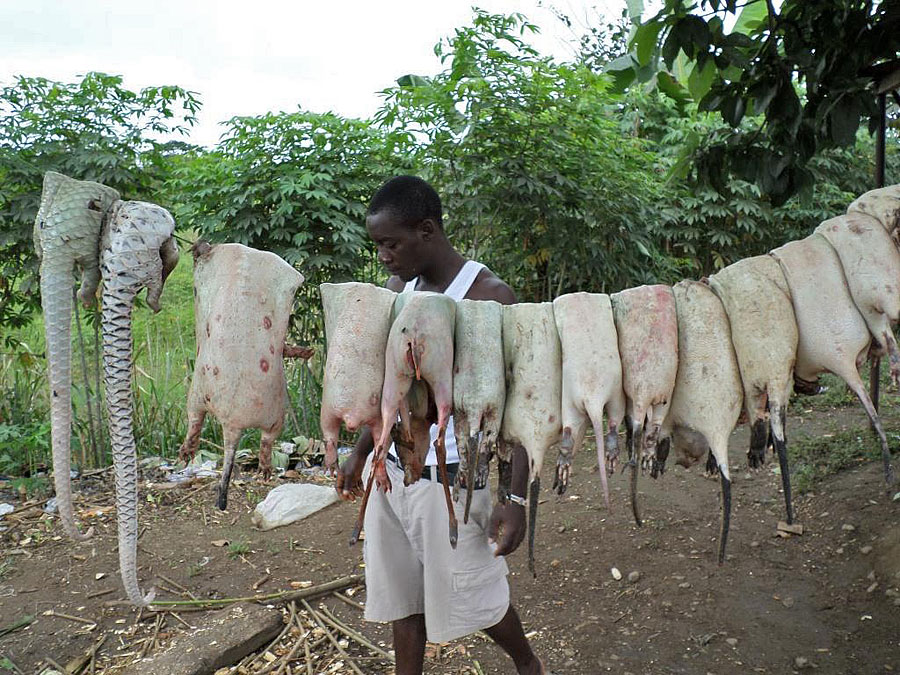The enigmatic pangolin, or scaly anteater, is literally being eaten out of existence according to the latest update of The IUCN Red List of Threatened Species™, which shows that all eight species are now threatened with extinction.
Resembling an artichoke with legs and a tail, the pangolin is the world’s only truly scaly mammal. Their scales act as armour against natural predators but offer no defence against poachers.
The IUCN Species Survival Commission (SSC) Pangolin Specialist Group, which is hosted by the Zoological Society of London (ZSL), warns that pangolins are now the most illegally traded mammal in the world, with more than one million individuals believed to have been snatched from the wild over the past decade.
Despite a commercial trade ban for wild-caught pangolins in Asia, the illegal trade is thriving. Consumers are willing to pay increasingly high prices for their meat, which is being plated up at banquets across the East as a luxury food. In traditional Chinese medicine, pangolin scales are also believed to treat a wide variety of conditions including psoriasis and poor circulation.
The illegal trade in pangolin species has reached an epic scale, with the Chinese and Sunda pangolins now classified as Critically Endangered. As the populations of the four Asian pangolin species plummet, traders are now looking to Africa to meet the growing demand.
“All eight pangolin species are now listed as threatened with extinction, largely because they are being illegally traded to China and Vietnam,” says Professor Jonathan Baillie, Co-Chair of the IUCN SSC Pangolin Specialist Group and Conservation Programmes Director at ZSL.
“In the 21st Century we really should not be eating species to extinction – there is simply no excuse for allowing this illegal trade to continue.”The IUCN SSC Pangolin Specialist Group is today launching a conservation action plan which lays out the steps that need to be taken to clamp down on the illegal trade and secure the future of pangolins in Asia and Africa.
Dan Challender, Co-Chair of the IUCN SSC Pangolin Specialist Group, says: “Our global strategy to halt the decline of the world’s pangolins needs to be urgently implemented. “A vital first step is for the Chinese and Vietnamese governments to conduct an inventory of their pangolin scale stocks and make this publicly available to prove that wild-caught pangolins are no longer supplying the commercial trade.”
The new action plan ‘Scaling up pangolin conservation’ focuses on protecting pangolin strongholds in Asia and Africa, helping local communities move away from poaching, the strengthening of legislation, and most importantly, understanding and reducing consumer demand.
ZSL
Founded in 1826, the Zoological Society of London (ZSL) is an international scientific, conservation and educational charity whose mission is to promote and achieve the worldwide conservation of animals and their habitats. Our mission is realised through our groundbreaking science, our active conservation projects in more than 50 countries and our two Zoos, ZSL London Zoo and ZSL Whipsnade Zoo.
IUCN
IUCN, the International Union for Conservation of Nature, helps the world find pragmatic solutions to our most pressing environment and development challenges by supporting scientific research; managing field projects all over the world; and bringing governments, NGOs, the UN, international conventions and companies together to develop policy, laws and best practice.
The IUCN Red List of Threatened Species™
Throughout 2014 we are celebrating the significant contribution of The IUCN Red List of Threatened Species™ (or The IUCN Red List) in guiding conservation action and policy decisions over the past 50 years. The IUCN Red list is an invaluable conservation resource, a health check for our planet – a Barometer of Life. It is the world’s most comprehensive information source on the global conservation status of plant, animal and fungi species. It is based on an objective system for assessing the risk of extinction of a species should no conservation action be taken.
Species are assigned to one of eight categories of threat based on whether they meet criteria linked to population trend, population size and structure and geographic range. Species listed as Critically Endangered, Endangered or Vulnerable are collectively described as ‘Threatened’. The IUCN Red List is not just a register of names and associated threat categories. It is a rich compendium of information on the threats to the species, their ecological requirements, where they live, and information on conservation actions that can be used to reduce or prevent extinctions.
The IUCN Red List is a joint effort between IUCN and its Species Survival Commission, working with its IUCN Red List partners BirdLife International; Botanic Gardens Conservation International; Conservation International; NatureServe; Microsoft; Royal Botanic Gardens, Kew; Sapienza University of Rome; Texas A&M University; Wildscreen; and Zoological Society of London.
Pangolins
Pangolins are highly evolutionarily distinct; they are the only representatives of an entire mammalian order, the Pholidota. If they went extinct then 80 million years of unique evolutionary history would be gone forever. Pangolins, also known as Scaly anteaters, are insectivorous mammals found in tropical regions of Africa and Asia. They are unique among mammals, being covered in overlapping, horny scales comprised of keratin. They vary in size and range in weight from 2 to 35kg.
There are both arboreal and ground-dwelling species, and most pangolins are predominantly nocturnal, and being insectivorous, they feed mainly on ants and termites. The name ‘pangolin’ comes from the Malay word ‘pengguling’ meaning ‘something that rolls up’, and which is the behaviour they display when they feel threatened Although previously grouped with the anteaters, sloths and armadillos, pangolins are now known to be most closely related to carnivores, from which they diverged approximately 80 million years ago.
More information on the action plan can be found at www.pangolinsg.org.


 CI is a non-profit, non-commercial portal that aims to facilitate wildlife and nature conservation by providing reliable information and the tools needed to campaign effectively.
CI is a non-profit, non-commercial portal that aims to facilitate wildlife and nature conservation by providing reliable information and the tools needed to campaign effectively.